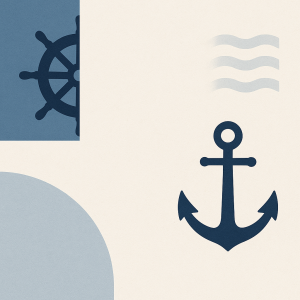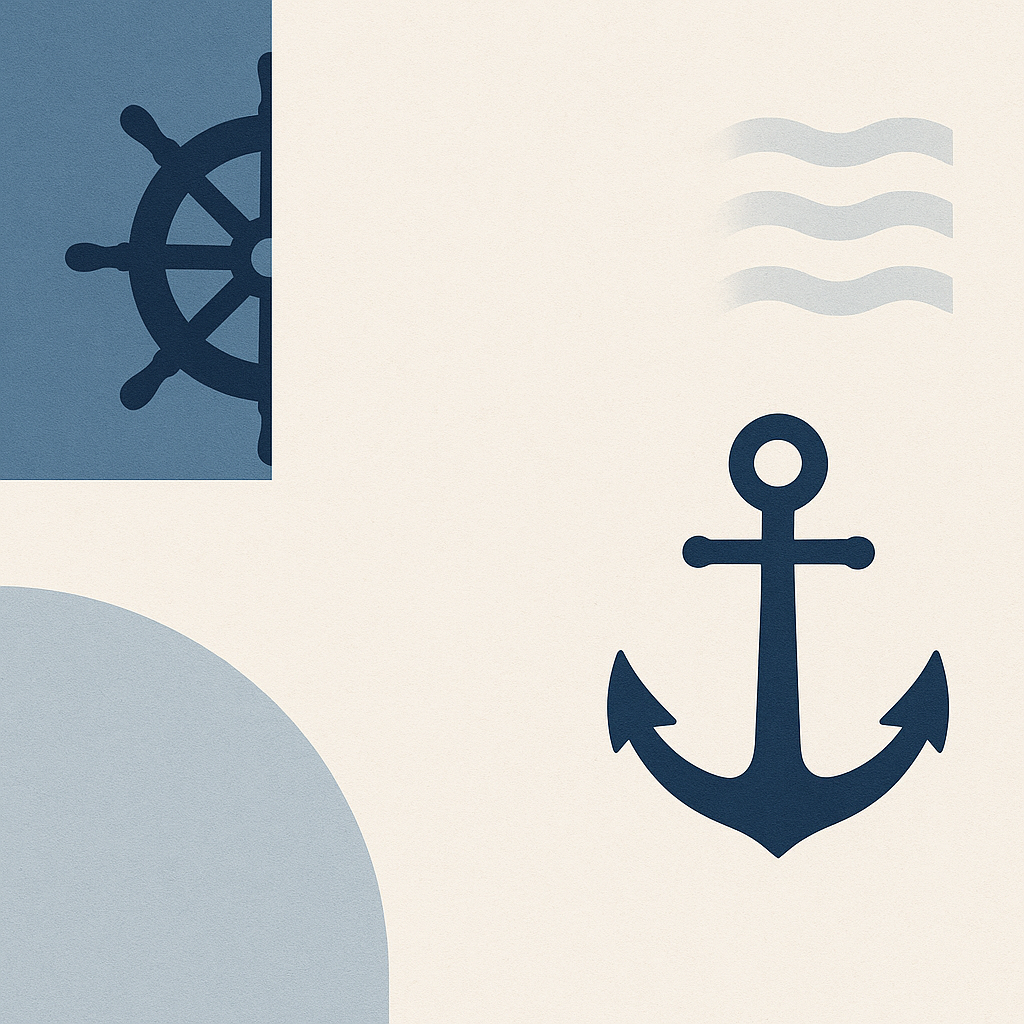Explore the essential maritime abbreviations and terminology every seafarer, student, or enthusiast should know. Learn how these terms shape communication, safety, and operations at sea.
Why Maritime Terminology Matters in Modern Maritime Operations
 Imagine this: you’re on the bridge of a merchant vessel off the coast of Singapore. A radio call crackles through: “Proceed to anchorage per CPA. ETA 1430 LT. Maintain CPA >0.5 NM. Report via VHF CH16.” If that sentence seems like a secret code, you’re not alone. The maritime world runs on a language of its own—full of abbreviations, acronyms, and technical phrases that compress vital information into a few words.
Imagine this: you’re on the bridge of a merchant vessel off the coast of Singapore. A radio call crackles through: “Proceed to anchorage per CPA. ETA 1430 LT. Maintain CPA >0.5 NM. Report via VHF CH16.” If that sentence seems like a secret code, you’re not alone. The maritime world runs on a language of its own—full of abbreviations, acronyms, and technical phrases that compress vital information into a few words.
This language isn’t about style—it’s about survival, safety, and swift operations. A misinterpreted term can delay a port operation, cause a navigational error, or worse, lead to an accident at sea.
To help global readers—from aspiring officers and marine engineers to port officials and shipping enthusiasts—this article decodes the most important maritime terminology, explains how and why it’s used, and shows how it contributes to the efficient, globalized movement of goods and people across the oceans.
The Roots of Maritime Language: History Meets Necessity
The language of the sea has evolved over centuries. British naval dominance in the 18th and 19th centuries heavily influenced modern maritime terms. Today, Standard Marine Communication Phrases (SMCP) approved by the IMO ensure that non-native English-speaking seafarers use globally understood terms for critical situations.
It’s not just tradition—it’s law. Under STCW Convention Section B-V/c, deck officers and ratings must demonstrate proficiency in maritime English, including abbreviations, phrases, and commands.
But maritime communication doesn’t stop at speech. From cargo manifests and GPS routes to safety signage and log entries, abbreviations are everywhere.
Categories of Common Maritime Abbreviations and Terminology
Let’s break down the essential maritime terminology into categories for better understanding.
Navigation and Bridge Watch Terms
Navigational abbreviations are essential for safe voyage planning, collision avoidance, and communication between ships and port control.
-
CPA – Closest Point of Approach
Used in collision avoidance via radar and AIS. A low CPA means a risk of collision. -
ETA / ETD – Estimated Time of Arrival / Departure
Time references used in voyage planning, port scheduling, and reporting. -
LT / UTC – Local Time / Coordinated Universal Time
Helps synchronize global maritime operations. -
AIS – Automatic Identification System
A tracking system used to monitor ship movements, mandatory for all SOLAS ships over 300 GT. -
COLREGs – International Regulations for Preventing Collisions at Sea
The backbone of maritime navigation rules. -
ECDIS – Electronic Chart Display and Information System
Digital navigation tool replacing paper charts. -
VTS / VTIS – Vessel Traffic Service / Vessel Traffic Information System
Monitors and manages maritime traffic near busy harbors or restricted waters.
Engineering and Technical Abbreviations
These terms are common in engine rooms, maintenance logs, and safety procedures.
-
ME / AE – Main Engine / Auxiliary Engine
ME propels the ship; AE powers onboard electrical systems. -
HFO / MGO / LNG – Heavy Fuel Oil / Marine Gas Oil / Liquefied Natural Gas
Fuel types with regulatory implications under MARPOL Annex VI. -
RPM / kW / kNm – Revolutions Per Minute / Kilowatt / Kilonewton metre
Units for power, torque, and speed—core to engine operation. -
LO / FO / FW – Lubricating Oil / Fuel Oil / Fresh Water
Monitored in daily engine room operations. -
IGS – Inert Gas System
Used on tankers to prevent explosive atmospheres in cargo tanks. -
SCR / EGR – Selective Catalytic Reduction / Exhaust Gas Recirculation
Key technologies for reducing NOx emissions in compliance with IMO Tier III limits.
Cargo and Commercial Shipping Abbreviations
Used by ship operators, freight forwarders, and port agencies.
-
B/L – Bill of Lading
A legal document detailing the cargo being transported. -
LOA / DWT / GT / NT – Length Overall / Deadweight Tonnage / Gross Tonnage / Net Tonnage
Measurements essential for port dues, cargo capacity, and compliance. -
FCL / LCL – Full Container Load / Less than Container Load
Common in container logistics. -
FOB / CIF / CFR – Free on Board / Cost, Insurance, Freight / Cost and Freight
Incoterms used in international trade to define responsibilities. -
ISM Code – International Safety Management Code
Mandates safety and pollution prevention standards onboard.
Safety and Emergency Terms
Critical during drills and actual emergencies.
-
LSA / FFA – Life-Saving Appliances / Fire Fighting Appliances
Terms used during inspections and audits. -
EPIRB / SART / GMDSS – Emergency Position-Indicating Radio Beacon / Search and Rescue Transponder / Global Maritime Distress and Safety System
Emergency communication systems mandated by SOLAS Chapter IV. -
MOB – Man Overboard
A critical emergency requiring immediate action. -
SRtP – Safe Return to Port
Requirement for passenger ships to maintain essential systems after damage. -
HRU – Hydrostatic Release Unit
Automatically deploys liferafts when submerged.
Regulatory Bodies and Codes
Understanding the alphabet soup of maritime authorities is vital for compliance.
-
IMO – International Maritime Organization
UN agency regulating shipping safety and environment. -
IACS – International Association of Classification Societies
Sets technical standards for ship construction and surveys. -
BIMCO / ICS – Baltic and International Maritime Council / International Chamber of Shipping
Industry bodies influencing ship chartering and crew welfare. -
SOLAS / MARPOL / STCW / ISPS
The four pillars of maritime law: safety, pollution, training, and security respectively.
Real-World Use Cases of Maritime Terminology
Port Clearance in Singapore
When a container ship enters Singapore Strait, the VTS will communicate via VHF:
“MT Horizon Star, this is Singapore VTIS. Maintain speed 12 knots, report CPA with vessel ‘Pacific Glory.’ Proceed to anchorage ‘B’ as per ETA 1400 LT.”
Every word here—MT (Motor Tanker), CPA, VTIS, ETA, LT—is an abbreviation understood instantly by trained mariners. Misunderstanding even one term could lead to misnavigation in one of the world’s busiest maritime zones.
Oil Spill Emergency Response
During a drill in a tanker, the chief officer calls out:
“Activate IGS. Deploy SOPEP kit. Notify MRCC via GMDSS. Ensure SART and EPIRB armed.”
Each abbreviation here plays a life-saving role: IGS prevents explosion, SOPEP (Shipboard Oil Pollution Emergency Plan) contains the spill, MRCC (Maritime Rescue Coordination Centre) initiates rescue, and GMDSS guarantees global emergency communication.
Challenges in Understanding Maritime Abbreviations
Language Barriers
Although English is the official language of maritime communication, many seafarers come from non-native English-speaking backgrounds. A misheard or misunderstood abbreviation could cause navigational errors or safety breaches.
Solution: Regular use of IMO’s SMCP, onboard language training, and use of visual aids like signage and placards.
Training Gaps for Cadets and New Crew
Newcomers often find abbreviations overwhelming—especially when multiple systems are being introduced during training or safety drills.
Solution: Institutions like Massachusetts Maritime Academy and The Nautical Institute now include structured modules on maritime abbreviations as part of STCW training.
Documentation Overload
Crew are often overwhelmed by excessive abbreviations in manuals, especially those translated from different flag states or manufacturers.
Solution: Use of IMO Model Courses and digital glossaries like those provided by Marine Insight and Thetius to standardize terminology.
Future Outlook: Will Maritime Jargon Become Smarter?
Maritime communication is evolving with digital transformation. Here’s what’s next:
-
AI-Powered Translation: Smart bridge systems may soon offer real-time translation and abbreviation expansion for multi-national crews.
-
Augmented Reality (AR) Labels: Wearable AR headsets could overlay expanded definitions and instructions on equipment tagged “LSA” or “SCR.”
-
Standardized Global Maritime English Certification: Being explored by the IMO and ILO to enhance crew interoperability.
-
Voice-Controlled Interfaces: Integrated with ECDIS or Engine Room Automation Systems, allowing commands like “Display CPA” or “Log RPM.”
Frequently Asked Questions (FAQs)
Why are maritime abbreviations used so widely?
To communicate essential information quickly, especially in time-sensitive or multilingual environments.
Are there official sources for learning maritime terminology?
Yes. IMO’s SMCP, STCW Model Courses, and publications from The Nautical Institute, Marine Insight, and classification societies offer verified terms.
What is the difference between SOLAS and MARPOL?
SOLAS focuses on ship safety, while MARPOL covers pollution prevention from ships.
Can a misunderstanding of abbreviations lead to accidents?
Yes. Incorrect interpretation of CPA, RPM, or EPIRB procedures has been linked to past maritime incidents (MAIB reports).
Are maritime abbreviations the same worldwide?
Yes. Most are standardized under IMO or ISO guidelines, but some regional variations may exist.
How do cadets best learn these terms?
Through structured training, practical drills, shipboard immersion, and using digital learning platforms.
What if I don’t understand a term while on watch?
Always ask the officer in charge. Clarification prevents error. Maritime communication values safety over assumption.
Conclusion
Maritime abbreviations and terminology form the universal language of the sea. From navigation and engineering to safety and law, understanding these terms is not just useful—it’s essential. Whether you’re commanding a ship, inspecting cargo, or managing onboard safety drills, fluency in maritime language can mean the difference between confusion and clarity, delay and efficiency, or in rare cases—life and death.
As the industry embraces smart shipping, digital navigation, and AI-driven automation, one thing remains constant: the sea still speaks its own language. And for those who wish to thrive in this domain, learning to speak that language is the first step.
References
-
IMO Standard Marine Communication Phrases (SMCP): https://www.imo.org/en/OurWork/Safety/Pages/SMCP.aspx
-
STCW Convention and Code: https://www.imo.org/en/OurWork/HumanElement/Pages/STCW-Convention.aspx
-
Marine Insight Glossary: https://www.marineinsight.com/maritime-glossary/
-
BIMCO Abbreviations and Terminology: https://www.bimco.org
-
The Nautical Institute: https://www.nautinst.org
-
Thetius Digital Maritime Innovation Reports: https://www.thetius.com
-
MAIB Safety Investigation Reports: https://www.gov.uk/government/organisations/marine-accident-investigation-branch
-
IACS Publications: https://www.iacs.org.uk


Perfect, thanks !